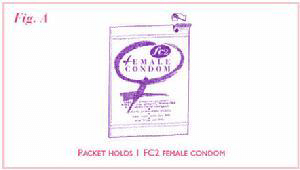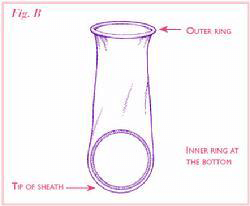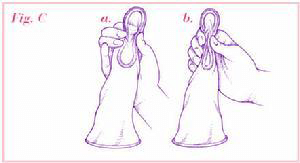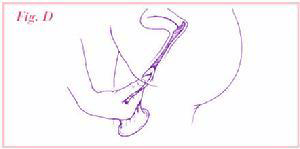Female condom
The female condom is not well known in Ethiopia. It is essentially a vaginal pouch (thin, loose-fitting and flexible plastic tube) with two rings at either end. (see figure 2 below). One end of the bag is open. The other end is closed. A woman inserts the closed end high up in her vagina over her cervix. The open end remains on the outside of her vagina. The vagina is now lined with the condom. When a woman has intercourse, the man inserts his penis into the open end of the woman's condom. Once intercourse is over and the man withdraws his penis, the condom containing the ejaculated sperm can now be removed and thrown away.
The female condom can be put in up to 8 hours before intercourse. A woman may need some practice before she can easily insert and position the condom within her vagina. The sides of the internal ring can be folded together and inserted into the vagina much like a diaphragm. The female condom is thinner than the male condom and is resistant to degradation by oil-based lubricants. A female condom should never be used when the man is also wearing a condom. The two condoms can stick together and tear, resulting in no protection at all

How to Use Female Condom
- Carefully open the packet.


- Find the inner ring, which is at the closed end of the condom.

- Squeeze the inner ring together.

- Put the inner ring in the vagina.

- Push the inner ring up into your vagina with your finger. The outer ring stays outside the vagina.

- When you have sex, guide the penis through the outer ring.

- Remove the female condom immediately after sex, before you stand up. Squeeze and twist the outer ring to keep the man‘s sperm inside the pouch. Pull the bag out gently, and then dispose of it out of reach of children and animals.
Mechanism of action:
- Female condoms work by forming a barrier that keeps sperm out of the vagina, preventing pregnancy.
- Also, keep infections in semen, on the penis, or in the vagina from infecting the other partner.
Effectiveness:
- Effectiveness depends on the user: Risk of pregnancy or sexually transmitted infection (STI) is greatest when female condoms are not used with every act of sex. Few pregnancies or infections occur due to incorrect use, slips, or breaks.
Protection against pregnancy:
- When used correctly with every act of sex, about five pregnancies per 100 women using female condoms over the first year.
Protection against HIV and other STIs:
- Female condoms reduce the risk of infection with STIs, including HIV, when used correctly with every act of sex.
Advantages:
- Unlike the male condom, erection is not necessary to keep the condom in place.
- Female condoms do not reduce a male partner's stimulation. Female condoms are made of plastic, which rarely causes an allergic reaction.
Disadvantages:
- Difficulty inserting the female condom.
- Inner ring uncomfortable or painful.
- Condom squeaks or makes noise during sex.
- Mild irritation in or around the vagina or penis.